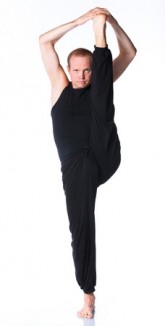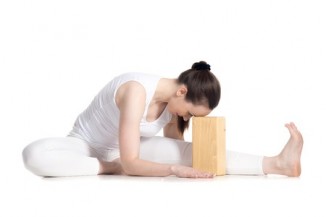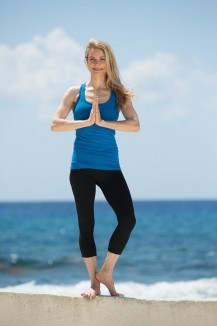When I tell people I teach yoga, at least half of them tell me, “Oh I’m way too inflexible to do yoga” or, “I can’t balance to save my life.”
Which, I get… I really do. When I first went to a yoga class and saw someone standing on their head, I panicked. At the time, I couldn’t even touch my toes, or imagine putting the top of my head on the floor.
But it also pains me to hear, because yoga is such an effective way of increasing flexibility and balance. And if you don’t do something about those tight muscles and wobbly ankles now, it’s not going to get better. In fact, it will only get worse.
Yoga May Be As Good As Aerobic Exercise for Your Heart
So, here are the 8 best ways to get over the idea that yoga isn’t for you–and start a fun, productive and lasting relationship with your own body.
1. Embrace Yourself As a Beginner
Having no idea what you’re doing is actually a beautiful thing. It relieves you of expectations. It makes you stay curious. It gives you the opportunity to try something new. How often does that happen in your life? Long-time yoga practitioners have to struggle to keep their minds open to new learning. You’ve got a blank slate–at least when it comes to yoga. Enjoy it. 
Check Out This Yoga Studio Made Entirely of Salt
2. Practice at Home
If the thought of being the person who’s pointing to the left when everyone else is pointing to the right is keeping you from going to a class, practice at home. There are yoga DVDs on Amazon, YouTube videos and online streaming services that will allow you to be in your own space and go at your own pace. At some point, you’ll want to take class with a teacher who will help you tailor the practice to your particular body. But if you aren’t quite ready to go to the class, bring the class to you.
3) Avoid Comparison
In every class, there will be someone—or maybe a whole posse of people—who will be able to do more than you. They will look glamorous and serene while you are red-faced and ready to bolt. Resist the urge to hate them—or yourself—and it will automatically deepen your practice.
Comparison make you focus on how you are separate, and yoga is about understanding how we are all connected. The more you can honor where you are today, the faster your current state will change.
4. Take a Beginner’s Class
It takes a special teacher to be able to truly serve beginners. Seek out the ones who have that skill by looking for the words “Level 1,” “beginner” or “basic” in the class description.
These classes will give you a firm foundation in the basic poses and make it much easier to keep up when you start going to more advanced classes.
5. Embrace Props

Blocks, straps, blankets, bolsters—or if you’re at home, couch cushions, belts and books—are your best friend! These props help you tailor a pose to fit your body, instead of contort (and potentially injure) your body to fit a pose.
Sit up on a folded blanket (or two, or three) in a forward bend, and see how much more likely you are to be able to touch your toes.
6. Talk to the Teacher
A good teacher wants to know about his or her students.
Introduce yourself a couple minutes before class starts and explain that you’re a beginner. He or she will be able to tell you how to modify poses during class to suit your level.
 7. Gently Check Your Ego at the Door
7. Gently Check Your Ego at the Door
I know it’s not fun to feel like a remedial student. But if you can resist the urge to go straight for the most advanced version of a pose, you’ll be able to build on your successes instead of potentially crashing and burning.
Tree pose is still tree pose, whether your foot is on your ankle, calf, or thigh. Once you’ve mastered the basic version, you can move on to the next level.
8. Listen to Your Body
Ultimately, your body will tell you everything you need to know about how yoga is working for you. Reach only as far as feels doable to you. “No pain no gain” does not apply on the yoga mat.
There’s always a next time to give you a chance to build on the stretching you have achieved today.
Kate Hanley is a yoga teacher, the author of A Year of Daily Calm: A Guided Journal to Creating Tranquility Every Day and the mind-body blogger for the online streaming fitness service, Acacia TV.
Send Your Friends Some Zen By Sharing This Story Below…





















My sister keeps pitching yoga at me. This article is very encouraging, but…I’m still wary of the “third lesson”. I’ve learned to “check my ego” for a variety of classes/lessons. The instructors and fellow students are very supportive and encouraging…until about the third lesson (or thereabouts). I’m still floundering, stumbling, mixing up my left from right and so on. The smiles become little more fixed, a little more plastic. The warmth in the voices drop to room temperature. “I’ve shown you this already.” “Are you practicing at home?” “This isn’t that difficult.”
If a yoga instructor does not say “This is the third session. You really should be able to stick your right pinky toe in your left ear by now.”, then it really is an activity above and beyond human norms.
Hi Murray,
The right teacher is so important, and not easy to find. If you get the vibe that your teacher thinks you’re lame, that’s not the teacher for you. He or she should definitely be firm enough to be clear with you — “this will get more possible if you practice it at home in between classes” — yet still be encouraging. But then again, going above and beyond human norms is kind of what yoga is all about. Not just externally, but internally. It’s about choosing to be awake instead of asleep, and continually putting yourself in situations that are just beyond what’s comfortable. And the desire to do that has to come from you — no teacher, no matter how skillful or compassionate — can place that within you. There is no right or wrong here, if it’s not there, no big deal. Then you can cheerfully tell your sister that it’s not your bag. But if you’re curious enough to go to class three times and read an article about how to love yoga…well, it sounds like there’s something there. 🙂
Good luck on your journey, wherever it may lead,
Kate